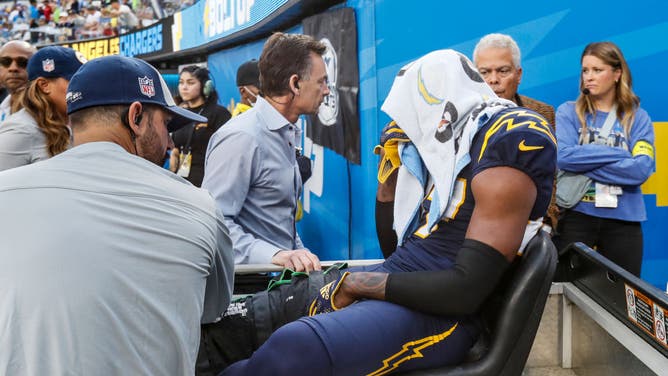NFLPA Missed Chance To Solve Grass-Turf Playing Surface Problem
NFL players should have asked for all playing surfaces to be natural turf when they had $1 billion in leverage in 2020.
That was the opinion of one NFL team executive in reaction to the growing chorus of players who have recently complained about the number of artificial turf playing surfaces around the league. Last week, NFL Players Association president J.C. Tretter published a strongly worded column on the union’s website and a number of team player representatives, such as Harrison Phillips of Minnesota and Dalton Schultz of Dallas, echoed his remarks with tweets.
The problem is that the best time to get such a change was roughly three years ago, when the most recent Collective Bargaining Agreement was being negotiated with the NFL. While the team executive was overwhelmingly sympathetic to the players’ cause, he was flabbergasted by the negotiating tactics.
“If the players say anything about this in 2020 when we’re talking about a 17th game, the owners give it to them. It’s not even really a debate because that’s how much the 17th game was worth,” the executive said.
Additionally, the executive agreed with the point that the players essentially contribute such a large amount to the building of stadiums that it is almost a no-brainer that they should have say over the fields. Under what is termed “exclusions” in the CBA, certain revenues are not counted toward the overall split.
That includes roughly $100 million per year (starting in 2020) toward the building of SoFi Stadium in Los Angeles, $40 million toward MetLife Stadium in New York. Additionally, any Personal Seat License, Premium Seat Revenue and Naming Rights fees that are used toward construction of stadiums is not counted. Specifics numbers for those categories are not spelled out in the CBA, but two sources said it is well into the “high” hundreds of millions and another said it is over $1 billion a year.
The upshot is that the players seemingly had leverage. So what happened?
Former NFLPA president Eric Winston, who served for six years and was part of the 2020 negotiations said the playing surface issue was not raised.
“You can always bargain for anything,” Winston wrote in a text. “I would probably take the tact that they (the owners) are obligated to provide safe working conditions for their employees.”
While that’s true, the flipside is that the history of the NFL prioritizing health and safety is, at best, questionable. Furthermore, it’s not like the NFLPA has never bargained on health and safety. In 2011, when current NFLPA executive director De Smith negotiated his first CBA, one of the main concessions he claimed to get from the owners was reductions in offseason and in-season practice, including limitations on padded practices.
The same thing happened in 2020 as the players agreed to play the 17th game.
Winston admitted he “largely” agreed on that point, which means that the standard has been set for how health and safety is handled. That was the larger point that the executive made while expressing frustration with the league’s position.
“The players should never have bargained on health and safety,” the executive said. “Once they did, it became part of the chess match. It’s part of the game that the owners play to get concessions from the players.”
It's a game that is not always wise, the executive admitted.
“Frankly, the teams should be going to grass fields because of what it potentially costs them in lost players and salary,” the executive said. “Yes, it’s a safety issue and we should care about the players. That’s absolutely true. But there’s an obvious increased cost risk and you don’t have to look too far to see it.”
The executive pointed out two injuries on the SoFi Stadium playing surface to make his point.
The first was the torn ACL that wide receiver Odell Beckham Jr. suffered in the Super Bowl as he helped the Rams beat Cincinnati. The other was when the Los Angeles Chargers lost cornerback J.C. Jackson earlier this season on the SoFi field that numerous players have complained about. Jackson suffered a torn patellar tendon, which is considered one of the toughest injuries to come back from.
“Think about it,” the executive said. “Beckham was dominating Cincinnati when he got hurt. Changed the game. The Bengals almost won, which would have been a disaster for the Rams. You’re talking about the Super Bowl in the balance and everything that means.”
As for Jackson, the Chargers gave him $40 million fully guaranteed as part of a five-year, $82.5 million deal.

Los Angeles Chargers cornerback J.C. Jackson is carted off the field after injuring his knee against the Seattle Seahawks at SoFi Stadium. (Getty Images)
“They paid Jackson and they had a plan for him,” the executive said. “We all deal with injuries, even to stars. But that’s another non-contact injury and you just wonder, ‘What are we doing?’ So you save a few million here or there with artificial turf. Is that really worth losing a player you paid so much money for and who you were hoping would be a star for you? It’s just nonsense.”
But, as the executive said, it is now part of the game that goes with negotiation.
“That’s why you see these stupid studies that the NFL puts out saying that artificial turf and grass are basically the same for injuries. I wouldn’t dare say that to one of our players. If I did, they’d probably never trust me again, then one of them would kick my ass,” the executive said.
“But this is what the players bargained. Maybe if it gets a little worse, the owners might change, but most of them just look at their staffs and said, ‘Take care of it,’” the executive said.